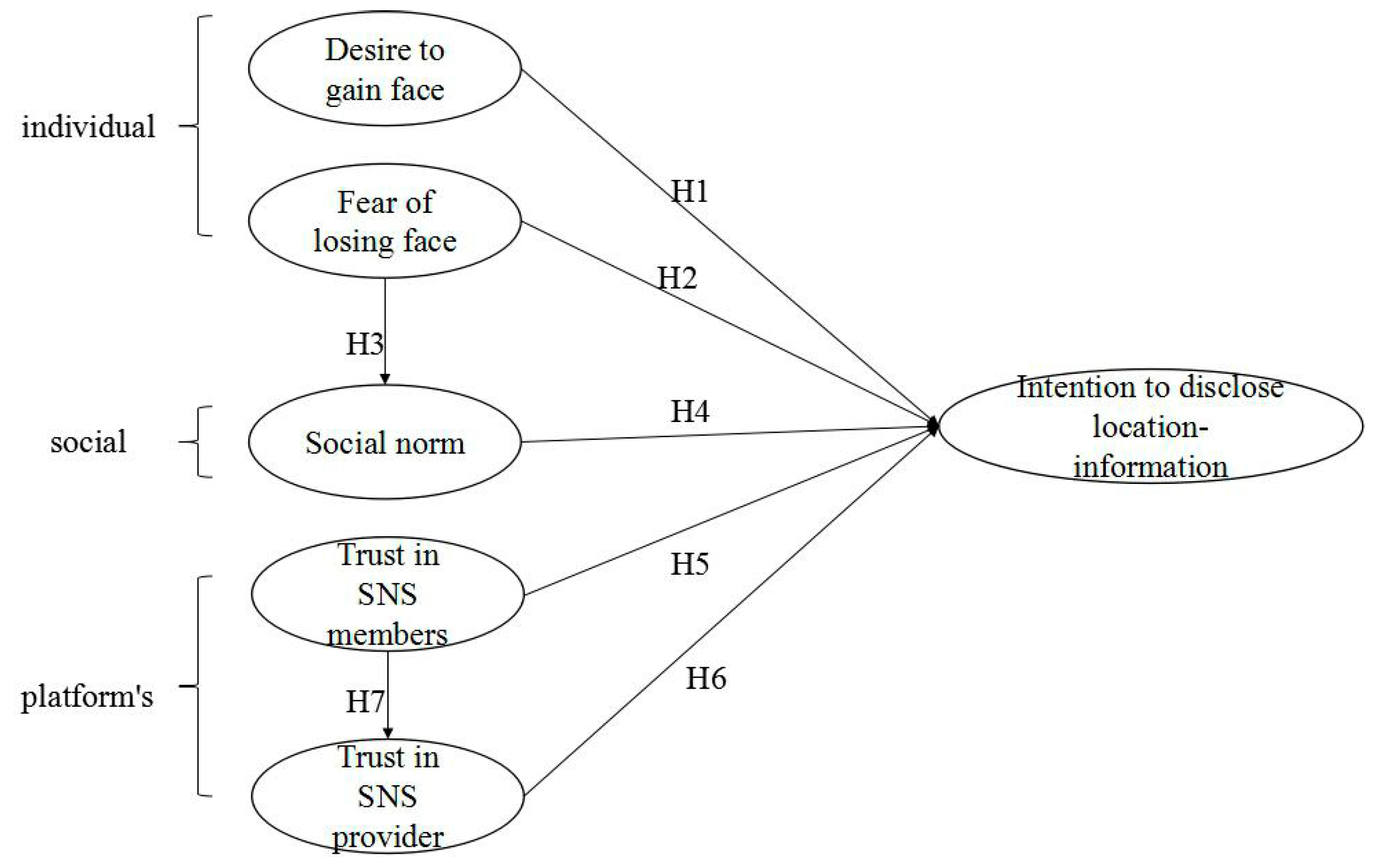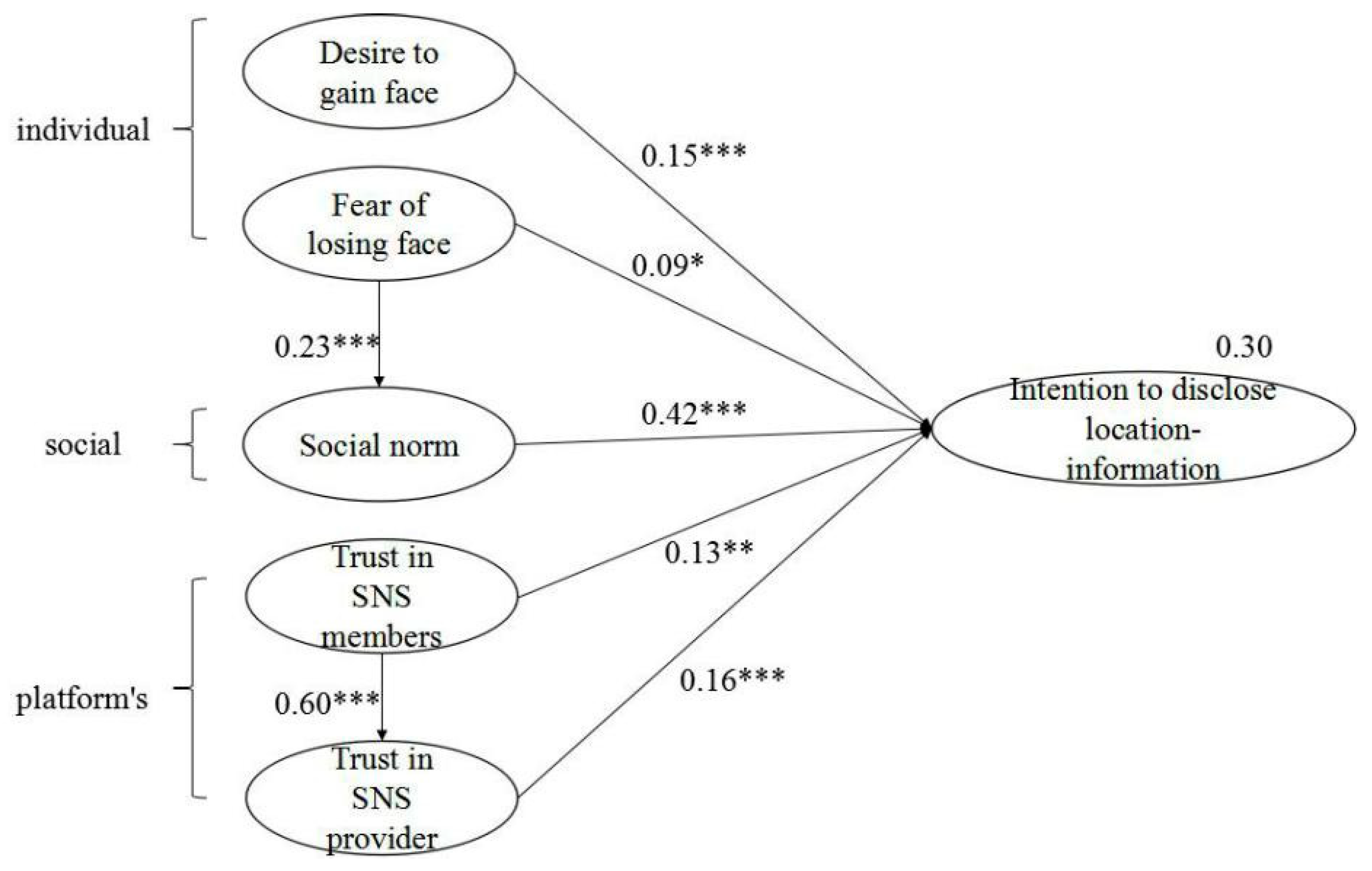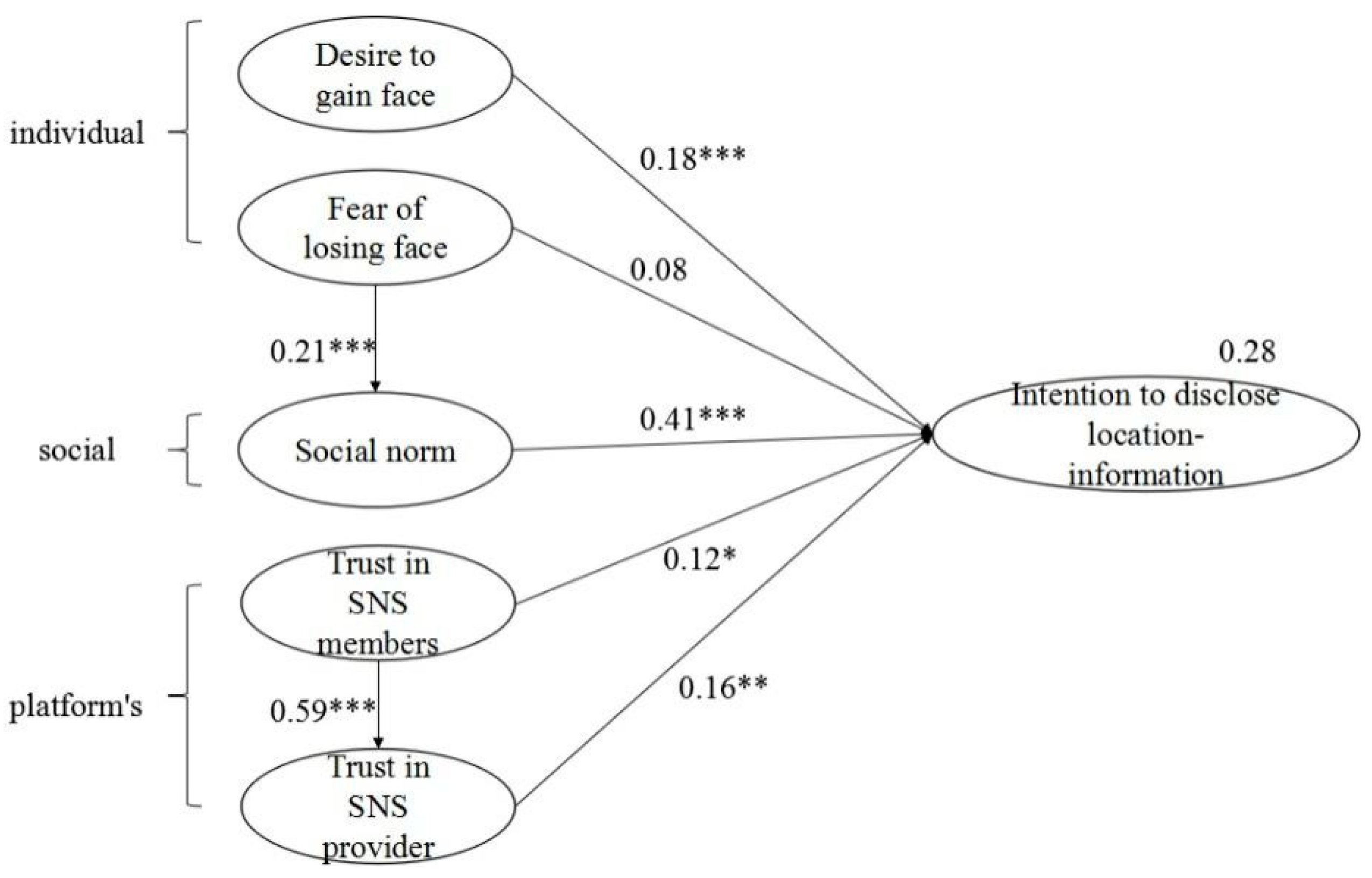Predictors of Chinese Users’ Location Disclosure Behavior: An Empirical Study on WeChat
Abstract
1. Introduction
2. Theoretical Background and Hypotheses
2.1. Location Information Disclosure on SNS
2.2. Face Consciousness
2.3. Social Norms
2.4. Trust
3. Method
3.1. Measures
3.2. Sample Characteristics
4. Results
4.1. Measurement Model
4.2. Structural Model
4.3. Post-hoc Analysis
5. Discussion
6. Conclusions
Author Contributions
Funding
Conflicts of Interest
Appendix A
| Constructs | Items | |
| Desire to gain face [10] | DG1 | I hope people think that I can do better than most others. |
| DG2 | I hope that I can talk about things that most others do not know. | |
| DG3 | I hope that I can possess things that most others thirst for. | |
| DG4 | It is important for me to get praise and admiration. | |
| DG5 | I hope that I have a better life than most others in others’ view. | |
| Fear of losing face [10] | FL1 | I always avoid talking about my weakness. |
| FL2 | I try to avoid letting others think that I am ignorant, even if I really am. | |
| FL3 | I do my best to hide my weakness in front of others. | |
| FL4 | If I work in an organization with a bad reputation, I will try not to tell others about that. | |
| FL5 | It is hard for me to acknowledge a mistake, even if I am really wrong. | |
| Social norm [11,33] | SN1 | If most of my schoolmates/colleagues thought that I should tag my location or “check in” on “Moments,” I would disclose my location the next time I used WeChat. |
| SN2 | If most of my friends thought that I should tag my location or “check in” on “Moments,” I would disclose my location the next time I used WeChat. | |
| SN3 | If most of my family members thought that I should tag my location or “check in” on “Moments,” I would disclose my location the next time I used WeChat. | |
| Trust in SNS provider [15,47] | In general, WeChat: | |
| TP1 | Makes good-faith efforts to address most member concerns. | |
| TP2 | Is honest in its dealings with me. | |
| TP3 | Makes and keeps its commitments to its members. | |
| TP4 | Is trustworthy. | |
| Trust in SNS members [15,47] | Generally, I trust that WeChat friends: | |
| TM1 | Will not use information about me in the wrong way. | |
| TM2 | Do care about the well-being of others. | |
| TM3 | Are trustworthy. | |
| TM4 | Are honest with each other. | |
| TM5 | Are open with each other. | |
| Intention to disclose location information [3] | LD1 | I am willing to disclose my location-related information using check-in functions. |
| LD2 | I intend to disclose my location-related information using check-in functions in the near future. |
References
- Boyd, D.M.; Ellison, N.B. Social network sites: Definition, history, and scholarship. J. Comput. Mediat. Commun. 2007, 13, 210–230. [Google Scholar] [CrossRef]
- Wang, S.S.; Stefanone, M.A. Showing off? Human mobility and the interplay of traits, self-disclosure, and facebook check-ins. Soc. Sci. Comput. Rev. 2013, 31, 437–457. [Google Scholar] [CrossRef]
- Luarn, P.; Yang, J.; Chiu, Y. Why people check in to social network sites. Int. J. Electron. Commer. 2015, 19, 21–46. [Google Scholar] [CrossRef]
- TNS. Mobile Life. Available online: http://www.199it.com/archives/35172.html (accessed on 14 May 2018).
- Gan, C. Understanding WeChat users’ liking behavior: An empirical study in China. Comput. Hum. Behav. 2017, 68, 30–39. [Google Scholar] [CrossRef]
- Tencent. The Report of WeChat “Influence”. Available online: http://tech.qq.com/a/20160321/ 007049.htm#p=1 (accessed on 14 January 2018).
- Koo, D.M. Impact of tie strength and experience on the effectiveness of online service recommendations. Electron. Commer. Res. Appl. 2016, 15, 38–51. [Google Scholar] [CrossRef]
- WALKTHECHAT. WeChat Impact Report 2018: All the Latest WeChat Data. Available online: https://walkthechat.com/wechat-impact-report-2016/ (accessed on 4 August 2018).
- Lin, J.; Benisch, M.; Sadeh, N.; Niu, J.; Hong, J.; Lu, B.; Guo, S. A comparative study of location-sharing privacy preferences in the United States and China. Pers. Ubiquit. Comput. 2013, 17, 697–711. [Google Scholar] [CrossRef]
- Zhang, X.; Cao, Q.; Grigoriou, N. Consciousness of social face: The development and validation of a scale measuring desire to gain face versus fear of losing face. J. Soc. Psychol. 2011, 151, 129–149. [Google Scholar] [CrossRef] [PubMed]
- Li, D.J.; Wu, B.; Wu, R.J. Chinese consumer purchase intention model—A modified model of Fishbein reasoned behavior model. Manage. World 2009, 1, 121–129. (In Chinese) [Google Scholar]
- Liu, J.; Rau, P.P.; Wendler, N. Trust and online information-sharing in close relationships: A cross-cultural perspective. Behav. Inf. Tech. 2015, 34, 363–374. [Google Scholar] [CrossRef]
- Bandura, A. Social Foundations of Thought and Action: A Social Cognitive Theory; Prentice-Hall: Englewood Cliffs, NJ, USA, 1986; pp. 169–171. [Google Scholar]
- Wang, Y.; Zheng, F. Review of factors and theories in overseas empirical study of SNS users’ personal information disclosure. J. Intell. 2016, 5, 201–207. (In Chinese) [Google Scholar] [CrossRef]
- Krasnova, H.; Spiekermann, S.; Koroleva, K.; Hildebrand, T. Online social networks: Why we disclose. J. Inf. Technol. 2010, 25, 109–125. [Google Scholar] [CrossRef]
- Wang, H.; Meng, Y.; Wang, W. The role of perceived interactivity in virtual communities: Building trust and increasing stickiness. Connect. Sci. 2013, 25, 55–73. [Google Scholar] [CrossRef]
- Chang, C.; Chen, G.M. College students’ disclosure of location-related information on Facebook. Comput. Hum. Behav. 2014, 35, 33–38. [Google Scholar] [CrossRef]
- Luszczynska, A.; Schwarzer, R. Social cognitive theory. In Predicting Health Behaviour, 2nd ed.; Conner, M., Norman, P., Eds.; Open University Press: Buckingham, UK, 2005; pp. 127–169. [Google Scholar]
- Wood, R.; Bandura, A. Social cognitive theory of organizational management. Acad. Manage. Rev. 1989, 14, 361–384. [Google Scholar] [CrossRef]
- Bandura, A. Social cognitive theory of mass communication. In Media Effects; Routledge: Abingdon, UK, 2009; pp. 110–140. [Google Scholar]
- Lent, R.W.; Brown, S.D.; Hackett, G. Toward a unifying social cognitive theory of career and academic interest, choice, and performance. J. Vocat. Behav. 1994, 45, 79–122. [Google Scholar] [CrossRef]
- Sun, Y.; Wang, N.; Shen, X.L.; Zhang, J.X. Location information disclosure in location-based social network services: Privacy calculus, benefit structure, and gender differences. Comput. Hum. Behav. 2015, 52, 278–292. [Google Scholar] [CrossRef]
- Chapman, C.N.; Lahav, M. International ethnographic observation of social networking sites. In Proceedings of the CHI ’08 Extended Abstracts on Human Factors in Computing Systems, Florence, Italy, 5–10 April 2008; pp. 3123–3128. [Google Scholar]
- Ardichvili, A.; Maurer, M.; Li, W.; Wentling, T.; Stuedemann, R. Cultural influences on knowledge sharing through online communities of practice. J. Knowl. Manag. 2006, 10, 94–107. [Google Scholar] [CrossRef]
- Goffman, E. Interaction Ritual: Essays in Face-to-Face Behavior; Transaction Publishers: Piscataway, NJ, USA, 1967. [Google Scholar]
- Bao, Y.Q.; Zhou, K.Z.; Su, C.T. Face consciousness and risk aversion: Do they affect consumer decision-making? Psychol. Mark. 2003, 20, 733–755. [Google Scholar] [CrossRef]
- Domino, G.; Affonso, D.; Slobin, M. Community psychology in the people’s republic of china. Psycholo. Int. J. Psycholo. Orient 1987, 30, 371–373. [Google Scholar]
- Lin, L.; Xi, D.; Lueptow, R.M. Public face and private thrift in Chinese consumer behaviour. Int. J. Consum. Stud. 2013, 37, 538–545. [Google Scholar] [CrossRef]
- Zhang, X. Consciousness of social face and conspicuous consumption of luxury products in the Chinese society. J. Market. Sci. 2012, 8, 74–94. [Google Scholar]
- Cheung, C.M.K.; Lee, M.K.O. A theoretical model of intentional social action in online social networks. Decis. Support Syst. 2010, 49, 24–30. [Google Scholar] [CrossRef]
- Latané, B. The psychology of social impact. Am. Psychol. 1981, 36, 343–356. [Google Scholar] [CrossRef]
- Oliveira, M.J.D.; Huertas, M.K.Z.; Lin, Z. Factors driving young users’ engagement with Facebook: Evidence from Brazil. Comput. Hum. Behav. 2016, 54, 54–61. [Google Scholar] [CrossRef]
- Hsu, C.L.; Lu, H.P. Why do people play on-line games? An extended TAM with social influences and flow experience. Inf. Manag. 2004, 41, 853–868. [Google Scholar] [CrossRef]
- Venkatesh, V.; Morris, M.G.; Davis, G.B.; Davis, F.D. User acceptance of information technology: Toward a unified view. MIS Quart. 2003, 27, 425–478. [Google Scholar] [CrossRef]
- Zlatolas, L.N.; Welzer, T.; Heričko, M.; Hölbl, M. Privacy antecedents for SNS self-disclosure: The case of Facebook. Comput. Hum. Behav. 2015, 45, 158–167. [Google Scholar] [CrossRef]
- Koohikamali, M.; Gerhart, N.; Mousavizadeh, M. Location disclosure on LB-SNAs: The role of incentives on sharing behavior. Decis. Support Syst. 2015, 71, 78–87. [Google Scholar] [CrossRef]
- Mayer, R.C.; Davis, J.H.; Schoorman, F.D. An integrative model of organizational trust. Acad. Manag. Rev. 1995, 20, 709–734. [Google Scholar] [CrossRef]
- Fukuyama, F. Trust: The Social Virtues and the Creation of Prosperity; Free Press: New York, NY, USA, 1995. [Google Scholar]
- Taddei, S.; Contena, B. Privacy, trust and control: Which relationships with online self-disclosure? Comput. Hum. Behav. 2013, 29, 821–826. [Google Scholar] [CrossRef]
- Xie, W.; Kang, C. See you, see me: Teenagers’ self-disclosure and regret of posting on social network site. Comput. Hum. Behav. 2015, 52, 398–407. [Google Scholar] [CrossRef]
- Morgan, R.M.; Hunt, S.D. The commitment-trust theory of relationship marketing. J. Mark. 1994, 58, 20–38. [Google Scholar] [CrossRef]
- Leimeister, J.M.; Ebner, W.; Krcmar, H. Design, implementation, and evaluation of trust-supporting components in virtual communities for patients. J. Manage. Inf. Syst. 2005, 21, 101–135. [Google Scholar] [CrossRef]
- Chang, C.; Heo, J. Visiting theories that predict college students’ self-disclosure on Facebook. Comput. Hum. Behav. 2014, 30, 79–86. [Google Scholar] [CrossRef]
- Malhotra, N.K.; Kim, S.S.; Agarwal, J. Internet users’ information privacy concerns (IUIPC): The construct, the scale, and a causal model. Inf. Syst. Res. 2004, 15, 336–355. [Google Scholar] [CrossRef]
- Liu, L.; Lee, M.K.O.; Liu, R.; Chen, J. Trust transfer in social media brand communities: The role of consumer engagement. Int. J. Inf. Manag. 2018, 41, 1–13. [Google Scholar] [CrossRef]
- Chen, J.; Shen, X.L.; Chen, Z.J. Understanding social commerce intention: A relational view. In Proceedings of the 47th Hawaii International Conference on System Sciences, Waikoloa, HI, USA, 6–9 January 2014; pp. 1793–1802. [Google Scholar]
- Contena, B.; Loscalzo, Y.; Taddei, S. Surfing on social network sites: A comprehensive instrument to evaluate online self-disclosure and related attitudes. Comput. Hum. Behav. 2015, 49, 30–37. [Google Scholar] [CrossRef]
- Hair, J.J.; Black, W.C.; Babin, B.J.; Anderson, R.E. Multivariate Data Analysis, 7th ed.; Prentice Hall: Englewood Cliffs, NJ, USA, 2009. [Google Scholar]
- Nunnally, J.C.; Bernstein, I.H. Psychometric Theory, 5th ed.; McGraw-Hill: New York, NY, USA, 1994. [Google Scholar]
- Fornell, C.; Larcker, D.F. Evaluating structural equation models with unobservable variables and measurement error. J. Mark. Res. 1981, 18, 39–50. [Google Scholar] [CrossRef]
- Chin, W.W.; Marcolin, B.L.; Newsted, P.R. A partial least squares latent variable modeling approach for measuring interaction effects: Results from a Monte Carlo simulation study and an electronic-mail emotion/adoption study. Inf. Syst. Res. 2003, 14, 189–217. [Google Scholar] [CrossRef]
- Amos, version 17.0; A Statistical Software Package for Structural Equation Modeling; SPSS Inc.: Chicago, 2008.
- Ting-Toomey, S.; Kurogi, A. Facework competence in intercultural conflict: An updated face-negotiation theory. Int. J. Intercult. Rel. 1998, 22, 187–225. [Google Scholar] [CrossRef]
- Mesch, G.S. Is online trust and trust in social institutions associated with online disclosure of identifiable information online? Comput. Hum. Behav. 2012, 28, 1471–1477. [Google Scholar] [CrossRef]



| Variables | Levels | Frequency | Percentage (%) |
|---|---|---|---|
| Gender | Male | 214 | 39.3 |
| Female | 331 | 60.7 | |
| Age | ≤20 | 149 | 27.3 |
| 21–25 | 223 | 40.9 | |
| 26–30 | 75 | 13.8 | |
| 31–50 | 81 | 14.9 | |
| >50 | 17 | 3.1 | |
| Education | High school or below | 29 | 5.3 |
| Two-year college | 118 | 21.7 | |
| Bachelor’s degree | 254 | 46.6 | |
| Master’s degree or higher | 144 | 26.4 | |
| WeChat usage experience | None | 0 | 0 |
| <1 year | 92 | 16.9 | |
| 1–3 years | 317 | 58.2 | |
| 4–5 years | 103 | 18.9 | |
| >5 years | 33 | 6.1 | |
| WeChat usage/day | None | 0 | 0 |
| <1 h | 176 | 32.3 | |
| 1–3 h | 207 | 38 | |
| 4–5 h | 62 | 11.4 | |
| >5 h | 100 | 18.3 | |
| WeChat friends | None | 0 | 0 |
| <50 | 144 | 26.4 | |
| 50–500 | 371 | 68.1 | |
| 500–1000 | 22 | 4 | |
| >1000 | 8 | 1.5 | |
| Number of locations disclosed on WeChat during past half year | None | 225 | 41.3 |
| 1–3 times | 157 | 28.8 | |
| 4–6 times | 77 | 14.1 | |
| 7–9 times | 36 | 6.6 | |
| >=10 times | 50 | 9.2 |
| Constructs | Mean | SD | CR | AVE | Cronbach’s α | DG | FL | SN | TM | TP | LD |
|---|---|---|---|---|---|---|---|---|---|---|---|
| DG | 4.328 | 1.033 | 0.866 | 0.565 | 0.853 | 0.752 | |||||
| FL | 3.704 | 0.973 | 0.856 | 0.544 | 0.820 | 0.556 | 0.738 | ||||
| SN | 3.630 | 1.342 | 0.911 | 0.773 | 0.926 | 0.234 | 0.233 | 0.879 | |||
| TM | 4.582 | 0.931 | 0.900 | 0.643 | 0.897 | 0.245 | 0.189 | 0.337 | 0.802 | ||
| TP | 4.389 | 1.014 | 0.890 | 0.671 | 0.901 | 0.240 | 0.140 | 0.341 | 0.596 | 0.819 | |
| LD | 4.080 | 1.390 | 0.852 | 0.741 | 0.907 | 0.335 | 0.287 | 0.533 | 0.386 | 0.395 | 0.861 |
| DG | FL | SN | TM | TP | LD | |
|---|---|---|---|---|---|---|
| DG1 | 0.745 | |||||
| DG2 | 0.803 | |||||
| DG3 | 0.786 | |||||
| DG4 | 0.712 | |||||
| DG5 | 0.708 | |||||
| FL1 | 0.744 | |||||
| FL2 | 0.746 | |||||
| FL3 | 0.841 | |||||
| FL4 | 0.677 | |||||
| FL5 | 0.667 | |||||
| SN1 | 0.86 | |||||
| SN2 | 0.908 | |||||
| SN3 | 0.868 | |||||
| TM1 | 0.71 | |||||
| TM2 | 0.787 | |||||
| TM3 | 0.845 | |||||
| TM4 | 0.873 | |||||
| TM5 | 0.785 | |||||
| TP1 | 0.792 | |||||
| TP2 | 0.878 | |||||
| TP3 | 0.847 | |||||
| TP4 | 0.753 | |||||
| LD1 | 0.852 | |||||
| LD2 | 0.87 |
© 2018 by the authors. Licensee MDPI, Basel, Switzerland. This article is an open access article distributed under the terms and conditions of the Creative Commons Attribution (CC BY) license (http://creativecommons.org/licenses/by/4.0/).
Share and Cite
Chen, S.; Shao, B.; Zhi, K. Predictors of Chinese Users’ Location Disclosure Behavior: An Empirical Study on WeChat. Information 2018, 9, 219. https://doi.org/10.3390/info9090219
Chen S, Shao B, Zhi K. Predictors of Chinese Users’ Location Disclosure Behavior: An Empirical Study on WeChat. Information. 2018; 9(9):219. https://doi.org/10.3390/info9090219
Chicago/Turabian StyleChen, Si, Bingjia Shao, and Kuiyun Zhi. 2018. "Predictors of Chinese Users’ Location Disclosure Behavior: An Empirical Study on WeChat" Information 9, no. 9: 219. https://doi.org/10.3390/info9090219
APA StyleChen, S., Shao, B., & Zhi, K. (2018). Predictors of Chinese Users’ Location Disclosure Behavior: An Empirical Study on WeChat. Information, 9(9), 219. https://doi.org/10.3390/info9090219




